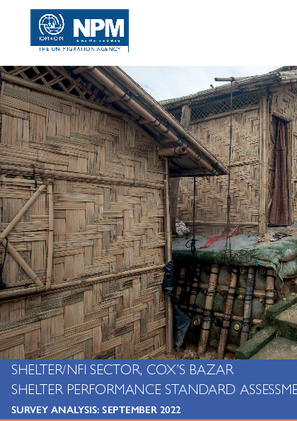-
Countries
-
Data and Analysis
-
Special Focus
-
Crisis Responses
Bangladesh — Shelter Performance Standard Assessment (September 2022)

Contacter
NPM Bangladesh, npmbangladesh@iom.int
Langue
English
Emplacement
Bangladesh
Période couverte
Mar 01 2021
Aug 09 2022
Activité
- Survey
- Community Perception
The total number of Rohingya refugees in Cox’s Bazar is around 936,733 individuals1 . The Rohingya refugee population is concentrated in 33 extremely congested camps within Ukhiya and Teknaf Upazilas of Cox’s Bazar district, Bangladesh. The refugees living in the camps are dependent on the assistance provided by the humanitarian community and the government of Bangladesh. Shelters are exposed to cyclic monsoons and face risk of floods, landslides, fire and cyclones. Temporary materials such as bamboo and tarpaulin have a limited capacity to resist weather impacts, and thus require regular repairs and replacement. Use of adequate material (treated bamboo, good quality tarpaulin) along with the design, site plan, proper technical details for the materials connections, can improve lifespan of materials if properly followed. Training for the beneficiaries on how to repair and maintain their shelters is also one of the essential elements of shelter assistance to ensure less dependency on humanitarian support. The below document represents findings from the joint assessment of the SNFI Sector and NPM on the Shelter Performance Standards which reflect shelters conditions across 33 camps.
